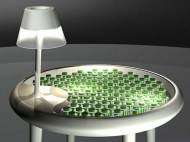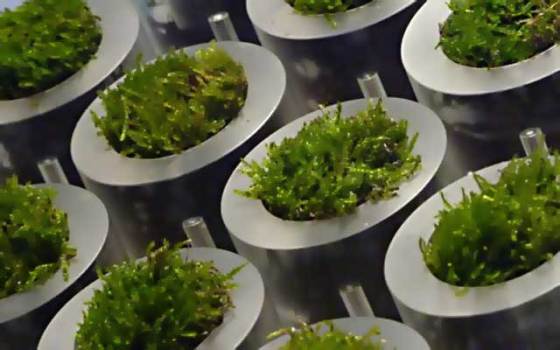Moss table employs biophotovoltaic technology to generate power
 Although many gardeners treat moss as a menace and tend to eradicate it from their lawns, a team of designers and scientists at the University of Cambridge are developing a way to harness energy from moss by using it as biophotovoltaics (BPVs). BPV devices may become competitive alternatives to conventional renewable technologies such as bio-fuels within the next ten years.
Although many gardeners treat moss as a menace and tend to eradicate it from their lawns, a team of designers and scientists at the University of Cambridge are developing a way to harness energy from moss by using it as biophotovoltaics (BPVs). BPV devices may become competitive alternatives to conventional renewable technologies such as bio-fuels within the next ten years.
The appeal of BPVs lies in their ability to harness a natural process that takes place all around us. Photosynthesis occurs when plants employ energy from sunlight in order to convert carbon dioxide from the atmosphere into nutrient organic compounds which help them to grow.
During photosynthesis, the moss releases some of these organic compounds into the soil which contains symbiotic bacteria which break down the compounds and liberate by-products that include electrons. The proposal of the Cambridge University team is to capture these electrons in order to produce electricity.
Alex Driver and Carlos Peralta from the Cambridge’s Institute for Manufacturing collaborated with Paolo Bombelli from the University’s Chemical Engineering and Biotechnology Department in order to create an example of the technology. The moss table is their vision of potential future where biological fuel cells made from moss produce the energy we need.
“The moss table provides us with a vision of the future. It suggests a world in which self-sustaining organic-synthetic hybrid objects surround us, and supply us with our daily needs in a clean and environmentally friendly manner”, said Carlos Peralta.
This pioneering work involves collaboration between the Departments of Chemical Engineering and Biotechnology, Biochemistry and Plant Sciences at Cambridge University, and the Chemistry Department at Bath University. The research is led jointly by Dr Adrain Fisher, Professor Christopher Howe and Professor Alison Smith at Cambridge, and Dr Petra Cameron at Bath.
The researchers envision this technology to be used as a modular system of biological solar panels could be mounted on to the roof of a building and provide a portion of its energy requirements. Giant algae-coated lily-pads floating on the surface of the ocean near the coastline could act as BPV power stations which generate energy for local communities. Algae solar collectors mounted on floating buoys and anchored just offshore could be used as BPV generators which could generate energy and harvest desalinated water.
Although they are cheap to produce and more environmentally friendly, the output generated by currently available BPVs is able to power small devices such as digital clocks. Another significant downside of this technology is the need for water which isn’t abundant in all the areas of the world.










The people involved in this project recently built a website where they plan to provide information about biophotovoltaic (BPV) technology and their achievements. They managed to build a prototype Moss Table able to produce about 520 Joules (J) of energy per day. Current version of technology enables the moss to provide about 50 milliwatts per square meter (mW/m2). With advancement of the technology, scientists expect that future versions might be able to generate up to 3W/m2.
http://www.youtube.com/watch?v=Tw7JcOHNZlY
While current version can’t produce enough electricity to power the lamp, it can power small devices such as digital clocks. The table is a concept product which demonstrates a potential future application of the technology, and the people involved into this project have plans to design and develop commercial products incorporating biophotovoltaic technology that could power digital clocks and devices with low power consumption.
For more information about the technology and Moss Table read the information posted on their website.
Awesome concept, but probably not maintenance free and not practical as a table since putting something on the table will block the light and thus reduce the power output. However I can envision this working with the average lawn to provide supplemental household power. Landscapers could sell sod panels with the electrodes already in place and just hook them up to a grid of low voltage wires.